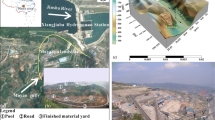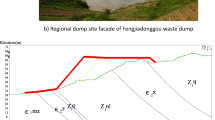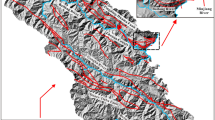Abstract
Long-term kinematic research of slowmoving debris slide is rare despite of the widespread global distribution of this kind. This paper presents a study of the kinematics and mechanism of the Jinpingzi debris slide located on the Jinsha river bank in southwest China. This debris slide is known to have a volume of 27×106 m3 in active state for at least one century. Field survey and geotechnical investigation were carried out to define the structure of the landslide. The physical and mechanical properties of the landslide materials were obtained by in-situ and laboratory tests. Additionally, surface and subsurface displacements, as well as groundwater level fluctuations, were monitored since 2005. Movement features, especially the response of the landslide movement to rainfall, were analysed. Relationships between resisting forces and driving forces were analysed by using the limit equilibrium method assuming rigid-plastic frictional slip. The results confirmed a viscous component in the long-term continuous movement resulting in the quasioverconsolidated state of the slip zone with higher strength parameters than some other types of slowmoving landslides. Both surface and subsurface displacements showed an advancing pattern by the straight outwardly inclined (rather than gently or reversely inclined) slip zone, which resulted in low resistance to the entire sliding mass. The average surface displacement rate from 2005 to 2016 was estimated to be 0.19~0.87 mm/d. Basal sliding on the silty clay seam accounted for most of the deformation with different degrees of internal deformation in different parts. Rainfall was the predominant factor affecting the kinematics of Jinpingzi landslide while the role of groundwater level, though positive, was not significant. The response of the groundwater level to rainfall infiltration was not apparent. Unlike some shallow slow-moving earth flows or mudslides, whose behaviors are directly related to the phreatic groundwater level, the mechanism for Jinpingzi landslide kinematics is more likely related to the changing weight of the sliding mass and the downslope seepage pressure in the shallow soil mass resulting from rainfall events.
Similar content being viewed by others
References
Barla G (2009) Long term behaviour of the Beauregard dam (Italy) and its interaction with a deep-seated gravitational slope deformation. In: 5th colloquium rock mechanics-theory and practice. Vienna University of Technology, Austria. pp 111–125.
Baum RL, Johnson AM (1993) Steady movement of landslides in fine-grained soils-A model for sliding over an irregular slip surface. U S. Geological Survey Bulletin. p1842.
Bertini T, Cugusi F, D’Elia B, et al. (1984) Climatic conditions and slow movements of colluvial covers in Central Italy. In: Proceeding of IV International Symposium on Landslides, Toronto. 1: 367–376.
Bertini T, Cugusi F, D’elia B, et al. (1986) Slow movement of the sideslope in the Abruzzo adriatic: characters and the criteria of stability. In: Proceeding of XVI National Conference on Foundations. Vol 1, Bologna. pp 91–100.
Cascini L, Calvello M, Grimaldi GM (2010) Groundwater modeling for the analysis of active slow-moving landslides. Journal of Geotechnical and Geoenvironmental Engineering 136(9): 1220–1230. https://doi.org/10.1061/(ASCE)GT.1943-5606.0000323
Cascini L, Calvello M, Grimaldi GM (2014) Displacement trends of slow-moving landslides: Classification and forecasting. Journal of Mountain Science 11(3): 592–606. https://doi.org/10.1007/s11629-013-2961-5
Chang SB, Zhang SM (2007) Engineering Geology Handbook. China Architecture and Building Press. pp 145–152. (In Chinese)
Chen L, Young MH (2006) Green-Ampt infiltration model for sloping surfaces. Water resources research 42(7): 887–896. https://doi.org/0043-1397/06/2005WR004468
Corominas J, Moya J, Ledesma A, et al. (1999) Monitoring of the Vallcebre landslide, Eastern Pyrenees, Spain. In: Yagi Yamagami and Jiang (eds.), Slope Stability Engineering. A.A. Balkema, Netherland. pp 1239–1244.
Corominas J, Moya J, Ledesma A, et al. (2005) Prediction of ground displacements and velocities from groundwater level changes at the Vallcebre landslide (Eastern Pyrenees, Spain). Landslides 2(2): 83–96. https://doi.org/10.1007/s10346-005-0049-1
Das BM (2008) Advanced soil mechanics. Taylor & Francis. pp 450–456.
Fernández-Merodo JA, García-Davalillo JC, Herrera G, et al. (2012) 2D viscoplastic finite element modelling of slow landslides: the Portalet case study (Spain). Landslides 11(1): 29–42. https://doi.org/10.1007/s10346-012-0370-4
Glastonbury JG, Fell RF (2008) Geotechnical characteristics of large slow, very slow, and extremely slow landslides. Canadian Geotechnical Journal 45(7): 984–1005. https://doi.org/10.1139/t08-021
González DA, Ledesma A, Corominas J (2008) The viscous component in slow moving landslides: A practical case. In: Chen ZY et al. (eds.), Landslides and Engineered Slopes, From the Past to the Future. Xi’an, China. pp 237–242. https://doi.org/10.1007/s10346-012-0370-4
Hu GT (1995) Landslide dynamics. Geology Press. pp 52–68. (In Chinese).
Huang S, Ding X, Zhang Y, et al. (2015) Triaxial test and mechanical analysis of rock-soil aggregate sampled from natural sliding mass. Advances in Materials Science and Engineering 2015: 1–14. https://doi.org/10.1155/2015/238095
Hutchinson JN (1988) General Report: morphological and geotechnical parameters of landslides in relation to geology and hydrogeology. In: Bonnar C (ed.), Proceedings of Fifth International Symposium on Landslide. A.A. Balkema, Netherland. Vol. 1, pp 3–36.
Jiang S, Wen BP, Zhao C, et al. (2016) Kinematics of a slowmoving giant landslide in Northwest China: Constraints from high resolution remote sensing imagery. Journal of Asian Earth Science 123(1): 34–46. https://doi.org/10.1016/j.jseaes. 2016.03.019
Keefer DK, Johnson AM (1983) Earthflows: morphology, mobilization and movement. USGS Professional Paper: 1264
Massey CI, Petley DN, McSaveney MJ (2013) Patterns of movement in reactivated landslides. Engineering Geology 159: 1–19. https://doi.org/10.1016/j.enggeo.2013.03.011
Matsuura S, Asano S, Okamoto T (2008) Relationship between rain and/or meltwater, pore-water pressure and displacement of a reactivated landslide. Engineering Geology 101(1): 49–59. https://doi.org/10.1016/j.enggeo.2008.03.007
Means RE, Parcher JV (1963) Physical properties of soils. Constable. pp 256–258.
Ministry of Land and Resources of the People’s Republic of China (2016) Code for geological investigation of landslide prevention. Standards Press of China. p 17. (In Chinese)
Moore PL, Iverson NR (2002) Slow episodic shear of granular materials regulated by dilatant strengthening. Geology 30(9): 843–846. https://doi.org/10.1130/0091-7613(2002)030<08 43:SESOGM>2.0.CO;2
Nakamura H (1984) Landslides in silts and sands mainly in Japan. In: Proceeding of IV International Symposium on Landslides, Toronto. pp 155–178.
Pánek T, Klimeš J (2016) Temporal behavior of deep-seated gravitational slope deformations: A review. Earth-Science Reviews 156: 14–38. https://doi.org/10.1016/j.earscirev.2016. 02.007
Picarelli L (2007) Considerations about the mechanics of slow active landslides in clay. In: Sassa K et al. (eds.), Progress in Landslide Science. Springer Berlin Heidelberg, Germany. pp 27–45.
Ranalli M, Gottardi G, Medina-Cetina Z, et al. (2010) Uncertainty quantification in the calibration of a dynamic viscoplastic model of slow slope movements. Landslides 7(1): 31–41. https://doi.org/10.1007/s10346-009-0185-0
Saito M (1969) Forecasting time of slope failure by tertiary creep. In: Proceeding of 7th international conference on soil mechanics and foundation engineering. Mexico City, Mexico. pp 677–683.
Sasaki Y, Fujii A, Asai K (2000) Soil creep process and its role in debris slide generation — field measurements on the north side of Tsukuba Mountain in Japan. Engineering Geology 56(1–2): 163–183. https://doi.org/10.1016/S0013-7952(99) 00141-6
Schulz WH, McKenna JP, Kibler JD, et al. (2009) Relations between hydrology and velocity of a continuously moving landslide—evidence of pore-pressure feedback regulating landslide motion? Landslides 6(3): 181–190. https://doi.org/10.1007/s10346-009-0157-4
Van Asch TWJ, Malet JP, Bogaard TA (2009) The effect of groundwater fluctuations on the velocity pattern of slowmoving landslides. Natural Hazards and Earth System Sciences 9(3): 739–749. https://doi.org/10.5194/nhess-9-739-2009
Van Asch TWJ, Van Beek LPH, Bogaard TA (2007) Problems in predicting the mobility of slow-moving landslides. Engineering geology 91(1): 46–55. https://doi.org/10.1016/j.enggeo.2006.12.012
Varnes DJ (1978) Slope movement types and processes. In: Schuster RL and Krizek RJ (eds.), Landslides, Analysis and Control, Special Report 176: Transportation Research Board, National Academy of Sciences, Washington, USA. pp 11–33.
Weidinger JT, Korup O, Munack H, et al. (2014) Giant rockslides from the inside. Earth & Planetary Science Letters 389(1): 62–73. https://doi.org/10.1016/j.epsl.2013.12.017
WP/WLI (1995) A suggested method for describing the rate of movement of a landslide. Bulletin of the International Association of Engineering Geology 52(1): 75–78.
Xu YH, Xu QM, Yang DY, et al. (2006) Formation and geological setting of the accumulations in Jinpingzi reach of the Jinshajiang river. Quaternary Sciences 26(3): 429–435. (In Chinese)
Author information
Authors and Affiliations
Corresponding author
Rights and permissions
About this article
Cite this article
Jiang, S., Wang, Yf., Tang, C. et al. Long-term kinematics and mechanism of a deep-seated slow-moving debris slide near Wudongde hydropower station in Southwest China. J. Mt. Sci. 15, 364–379 (2018). https://doi.org/10.1007/s11629-017-4473-1
Received:
Revised:
Accepted:
Published:
Issue Date:
DOI: https://doi.org/10.1007/s11629-017-4473-1




